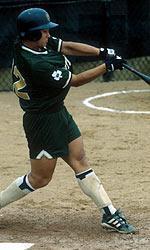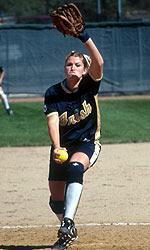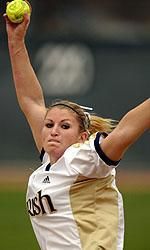May 5, 2005
by Alan Wasielewski
Notre Dame head softball coach Deanna Gumpf had just made a quick trip to the pitcher’s circle to check on game two starter Heather Booth. The junior had been struggling with her control and the Irish, already down one run to Providence on the road, could not afford to allow the Friars to add an insurance run.
A 5-10 righthander took off her jacket and half-walked, half-skipped to the pitcher’s circle. Steffany Stenglein, fresh off tossing a career-high 15 strikeouts in game one against Providence, was called on for relief in game two. Before her first pitch, Stenglein bent down in the back of the circle and wrote the words Jesus, Mary and Joseph – her usual pre-inning routine, in the dirt with her right index finger.
The energy on the field suddenly changed in Notre Dame’s direction. Stenglein had allowed just one hit to the Friars in game one (a single in the bottom of the seventh inning) and Providence suddenly realized that it was not going to score again.
Stenglein shut the door in game two, striking out three of the five batters she faced and Notre Dame rallied in the top of the seventh to post a 5-4 victory.
Pitching well before that double-victory at Providence, Stenglein quickly decided to switch into a whole different gear for the remainder of the 2005 season. In her next six starts, the Huntington Beach, Calif., native would post 79 strikeouts and vault herself into the national leaders in strikeouts, wins and ERA.
Stenglein’s career track at Notre Dame has been a roller coaster ride. Thrust into a surprise staff ace role her freshman year, she responded by pitching the Irish within two wins of the College World Series in 2002.
She was battling through serious pain from a hip injury, however, and after five months of rest in an attempt to heal the injury, she struggled through her sophomore season. After allowing a close-to-unheard of 20 home runs in 26 appearances and compiling a 3.76 ERA during the 2003 season, Stenglein was left wondering if she would ever be a productive pitcher again.
Hip surgery during the summer of 2003 fixed the physical problem and she came back stronger and more focused for the 2004 season. Stenglein would win 21 games during the year and became the second Irish pitcher to earn the BIG EAST Pitcher of the Year award.
Now, in 2005, Stenglein is piling up strikeouts and wins at a record pace – as she has already become Notre Dame’s all-time leader in pitching appearances and starts while assuming second place on the all-time strikeout list, wins and innings pitched lists.
Just where did this dominating pitcher, called “Stinger” by her teammates and coaches, come from?
Stenglein originally committed to play softball for Lu Harris at Southern Mississippi. Harris was hired to coach at the University of Georgia shortly thereafter and Stenglein’s affinity for Southern Mississippi quickly dissipated.
“Coach Harris called me and said she was going to leave for Georgia,” Stenglein said.
“She said I could wait and see who the new coach was going to be and I waited until August, but by then I knew that I did not want to go to Southern Mississippi.”
Stuck in limbo, Stenglein enrolled at Golden West junior college, continued to pitch for travel teams in Southern California and fielded offers from a number of different Division I schools (she did not play softball for Golden West, keeping her NCAA eligibility at four years). One night, sitting around the dinner table, her Uncle Walt decided to take matters into his own hands.
With Steffany’s backing, Walt wrote a letter to then-head coach at Notre Dame Liz Miller. One of Stenglein’s dreams was to play for the Fighting Irish and little did she know the letter was going to arrive at a perfect time.
Notre Dame was fresh off the most successful season in the program’s history. Finishing 54-7 and just one win away from the College World Series, the Irish were set to welcome back the core of the ’01 team and freshman All-American pitcher Kristin Schmidt.
Schmidt threw a wrench in the plans, however. Not happy under the Golden Dome, she announced her intention to transfer from Notre Dame just hours after the Irish were eliminated from the NCAA regional in Iowa City.
Stenglein’s letter would arrive at a program in flux, as Liz Miller announced her retirement during the offseason and Gumpf would step in to take over for her mentor – but with only two pitchers on the roster (freshman-to-be Carrie Wisen and junior Jessica Sharron).
Gumpf decided to give Lu Harris a call first to inquire about Stenglein.
“We called Lu and asked about Steffany and she said this is a girl that is raw and throws hard,” Gumpf said.
“I went out and watched her and she was exactly what Lu said. We also had to challenge her to reach a few academic goals in junior college to get into Notre Dame. Everything we asked for she did.”
Stenglein had the velocity, which allowed her to rank third in the country for strikeouts in her senior year of high school, and the Irish coaches saw enough potential to offer a scholarship to Notre Dame.
“I had to get `Bs’ or better in all my classes and attain a certain GPA to get into Notre Dame,” Stenglein said.
“I had signed up for a few classes that would not transfer, so after some adjustments I ended up in the correct classes. Right when I took my trip to Notre Dame I knew I wanted to come here, all I had to do was wait for my grades.”
Stenglein was accepted at Notre Dame and enrolled for the fall of 2002. Little did she know, however, that she would end up making a record number of appearances for the Irish during her rookie year.
Stenglein would combine with fellow freshman Carrie Wisen to lead the Irish pitching staff through the 2002 season. The Irish recovered from a rough 8-12 start to win 27 out of 28 games during the months of March and April. A large part of the team’s success was Stenglein’s quick development.

Jarrah Myers, who was Notre Dame’s starting catcher in 2000, 2001 and 2002, played a key role in Stenglein’s development during her rookie season.
|
“One of the keys to Steffany’s development was working with (then All-American starting catcher) Jarrah Myers,” Gumpf said.
“Jarrah would not take `No’ for an answer. She would not accept mediocrity. That relationship was the most important aspect of Steff’s development. I taught her the pitches and Jarrah taught her how to fight. Jarrah taught her something special.”
An All-American and Academic All-American catcher for the Irish, Myers would help guide Stenglein through her rookie season to earn all-BIG EAST first team honors and NFCA all-region honors. She would pitch 54 times in 2002, start 47 games, win 27 and pitch 250.2 innings – all single-season highs at Notre Dame. She also struck out 216 batters and posted a 1.93 ERA.
Her rookie season was not without its share of drama, however. While warming up for a game during Spring Break, Stenglein felt a twinge of pain in her hip. Slowly through out the season the pain increased until she found herself staring postseason play in the face while experiencing sharp pain on every pitch.
“There was pain on every throw and I couldn’t walk very well,” Stenglein said.
“There were also days when it hurt worse, that’s for sure.”
After throwing a perfect game against Virginia Tech during the regular season, Stenglein was roughed up for three solo home runs by the Hokies in an 8-3 loss in the first game of the BIG EAST Championship. That game was quickly followed by a memorable argument between pitcher and catcher.
“I was nervous that entire tournament because Jarrah and I got in a fight,” Stenglein said.
“We were arguing over my performance and my pitches, what to throw at what time.”
Myers still remembers the conversation well.
“I was a little angry and wanted to light a fire under her,” Myers said.
“I told her that she was throwing scared and if she was going to do that, she might as well just go sit on the bench.”
The argument not only motivated the battery, but the team as well. The Irish rallied back to win the conference title – with Stenglein pitching the Irish to victory over Virginia Tech twice on the final day of the tournament.
Stenglein entered the regional still feeling pain in her hip, but with a burst of confidence from the BIG EAST tournament finish. Pitching on pure guts and determination, she defeated No. 22 Iowa in game one of the tournament by scattering seven hits and allowing just two runs. She suffered a tough 2-0 loss to Oregon State in the next game, holding the Beavers down without much help from her offense.
Notre Dame would be required to face Oregon State again in an elimination game and Stenglein came up with a gem of a performance, allowing just two hits to the Beavers as the Irish earned the right to face No. 7 Nebraska on the final day – needing to defeat the Cornhuskers twice to move onto the College World Series.
The game started out fine for the Irish, who grabbed a 2-0 lead in the second inning. Stenglein eventually tired out, however, and gave up four runs in the sixth inning as Nebraska advanced to Oklahoma City.
“In that last game I really wished that I was not hurt,” Stenglein said.
“I got to the point where I really could not even walk to the rubber. Jarrah came out and said that I was done.”

Stenglein, shown here pitching during the 2002 season, ended up just two wins away from the College World Series as a freshman.
|
While the season ended on a down note, Stenglein still had three more years ahead of her and looked forward to being fully-healthy during her sophomore season.
At first, the Irish coaches and training staff decided to rest Stenglein during the offseason, hoping the injury would heal with rest. Stenglein did not pitch or work out for close to five months, only starting to throw during the preseason workouts for the 2003 season.
The pain quickly returned, however, and Stenglein would struggle mightily during her second year. With no leg power behind her pitches, she ended up allowing 20 home runs in 26 appearances and watching her ERA balloon to 3.76 for the season.
“I pretty much questioned myself the entire year,” Stenglein said.
“I talked to coach the whole year and told her that I hate (not pitching well). She told me I was going to be okay. I think she knew I was not where I was the year before and she was patient with me.”
Gumpf remembers well the struggles her pitcher went through in 2003.
“Mentally, that year killed her,” Gumpf said.
“After her sophomore year, I did not know if she would have the guts to come back and be productive. It was a very challenging year. She almost gave up. But, back to her freshman year, we had a bond. I depended on her and she depended on me. If we did not have that bond, I do not think she would have made it.”
After the season, Stenglein had her hip scoped and found out that her hip socket cartilage was shredded. The procedure cleared up the injury and she came into the 2004 season at full strength.
“She believed that she could come back,” Gumpf said.
“She got the surgery and it changed everything for her.”
The key turning point of the 2004 season was Stenglein’s performance in an exhibition game against the U.S. Olympic Team. The Olympians were taking advantage of the college preseason tournament schedule to begin their push toward the 2004 summer games – where the team would win the gold medal.
Stenglein pitched three innings of great softball against the best team in the world, holding the team to three hits and just one run.
“She owned them and just shut them down,” Gumpf said.
“The game did not even count but she held them down. It was a big boost to her confidence.”
Stenglein would eventually roll through the 2004 season and earn the BIG EAST Pitcher of the Year award – joining Jennifer Sharron (four consecutive awards from 1998-2001) as the only Irish pitches to earn the trophy. She ended up 9-1 in conference play with a 0.49 ERA.
“Last year, it was good to get the award knowing that I came back, fought and did not give up,” Stenglein said.
“But I wanted to get to the World Series and did not get there. That is the ultimate goal for the team.”
With a more intensive offseason workout plan in place, Stenglein entered the 2005 season stronger than she ever felt before. Her curve ball, once just a secondary pitch, became her primary weapon – making opponents knees buckle at an astounding rate.
She has struck out 10 or more batters 13 times this season (in 24 starts) and has failed to strikeout at least six batters in only one start in which she threw more than four innings. She also blew by the 500, 600 and 700 strikeout barrier this season, moving into second place on the all-time strikeout list with 737 (as of May 5). In 2005, she became just the second Irish pitcher to reach 250 Ks in a single season (Terri Kobata reached 250 twice in her career).
Across the board, Stenglein is having a career season. She has a 19-5 record entering the final weeks of the season with a stellar 1.15 ERA. Even more impressive, she has given up just 75 hits this season (3.3 per seven innings) and opponents are hitting just .141 against her.
“I think my confidence is rising,” Stenglein said.
“For a while, I only threw five innings because I was not strong enough to finish off the game. I started to work out more and get in better condition. Now, I know I am not tired at the end of the game.”
At the end of her senior year, when Stenglein enters the game, she has an edge over her opponents. Blessed with a powerful arm and a wicked curve ball, the Irish staff ace knows that with her personal legacy assured, she can focus on taking her team as far as she can in the postseason.
The struggles that she battled through during her career also give her a unique perspective on her four years of college competition.
“I am still amazed I am at Notre Dame and how it happened,” Stenglein said.
“God put me here for a reason. Everything I went through, I went through for a reason. It has been an awesome experience.”







